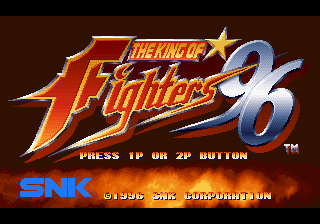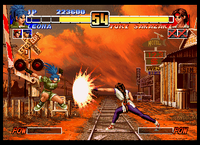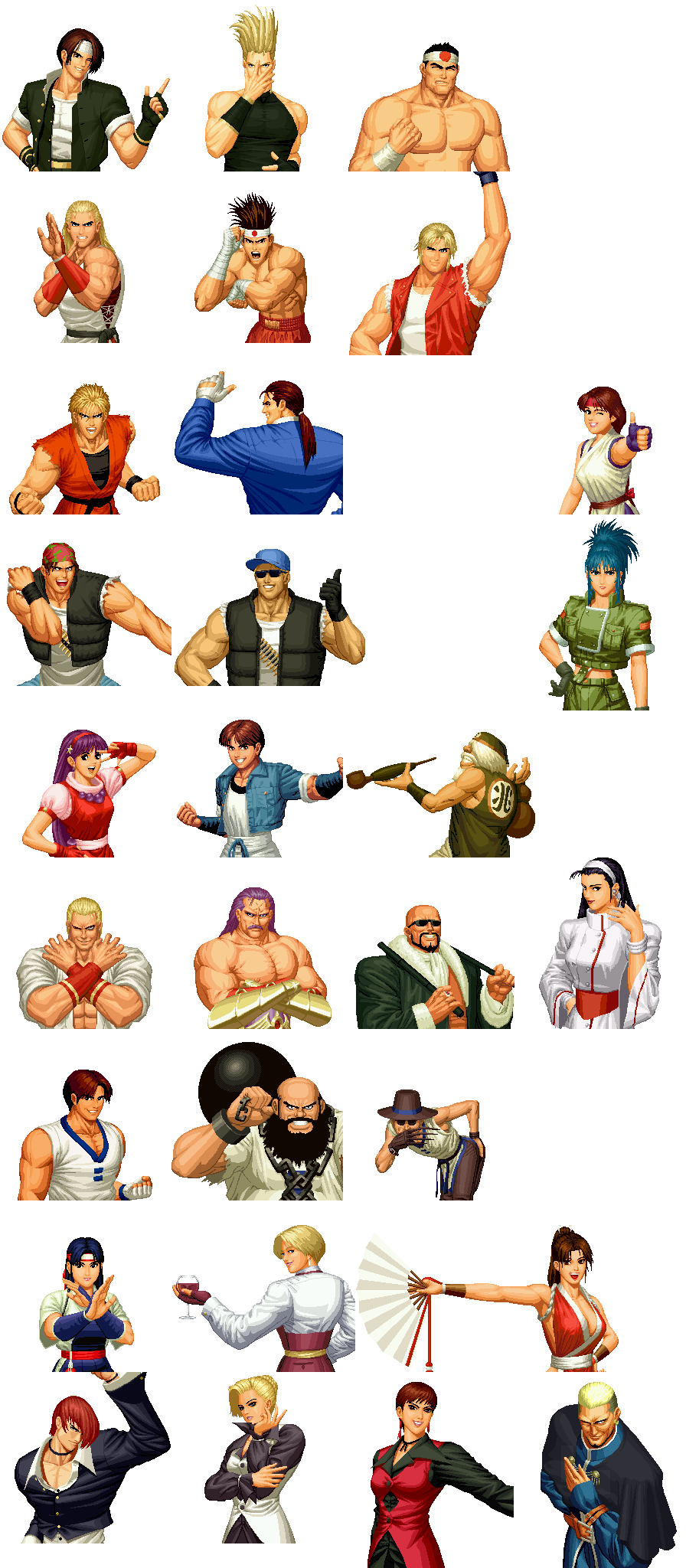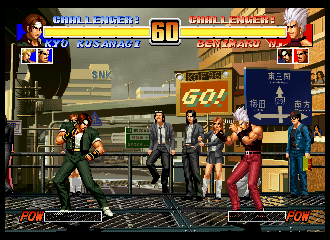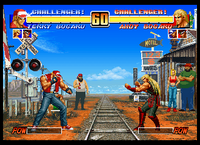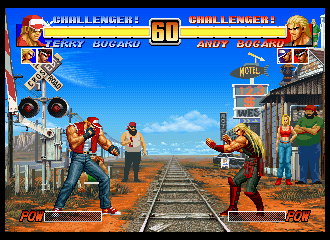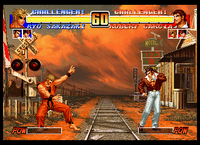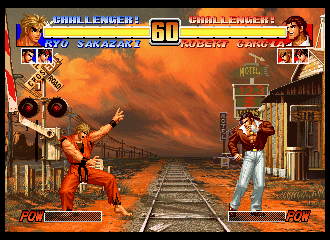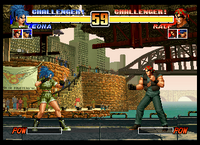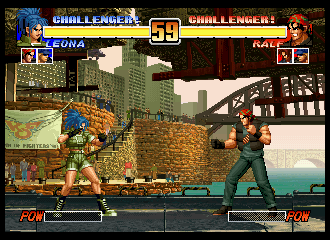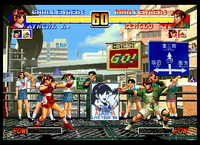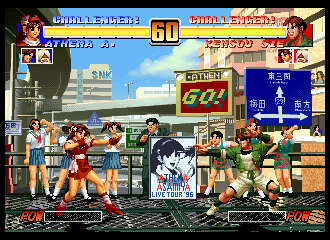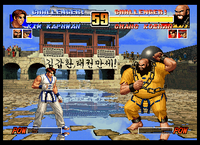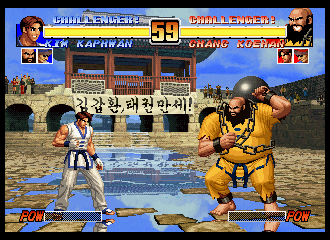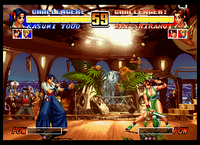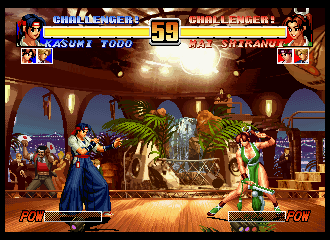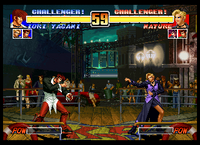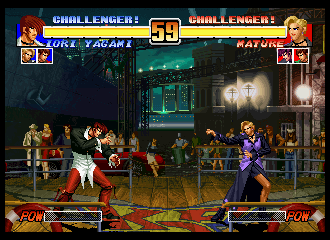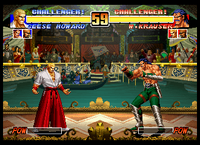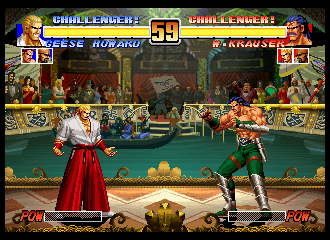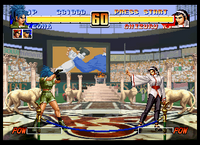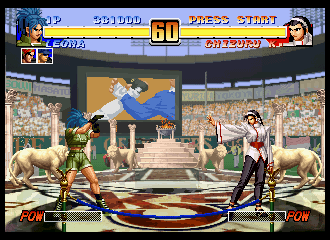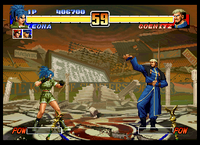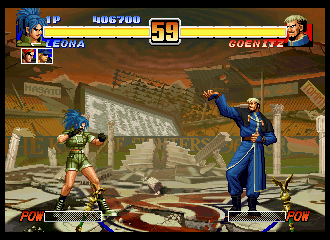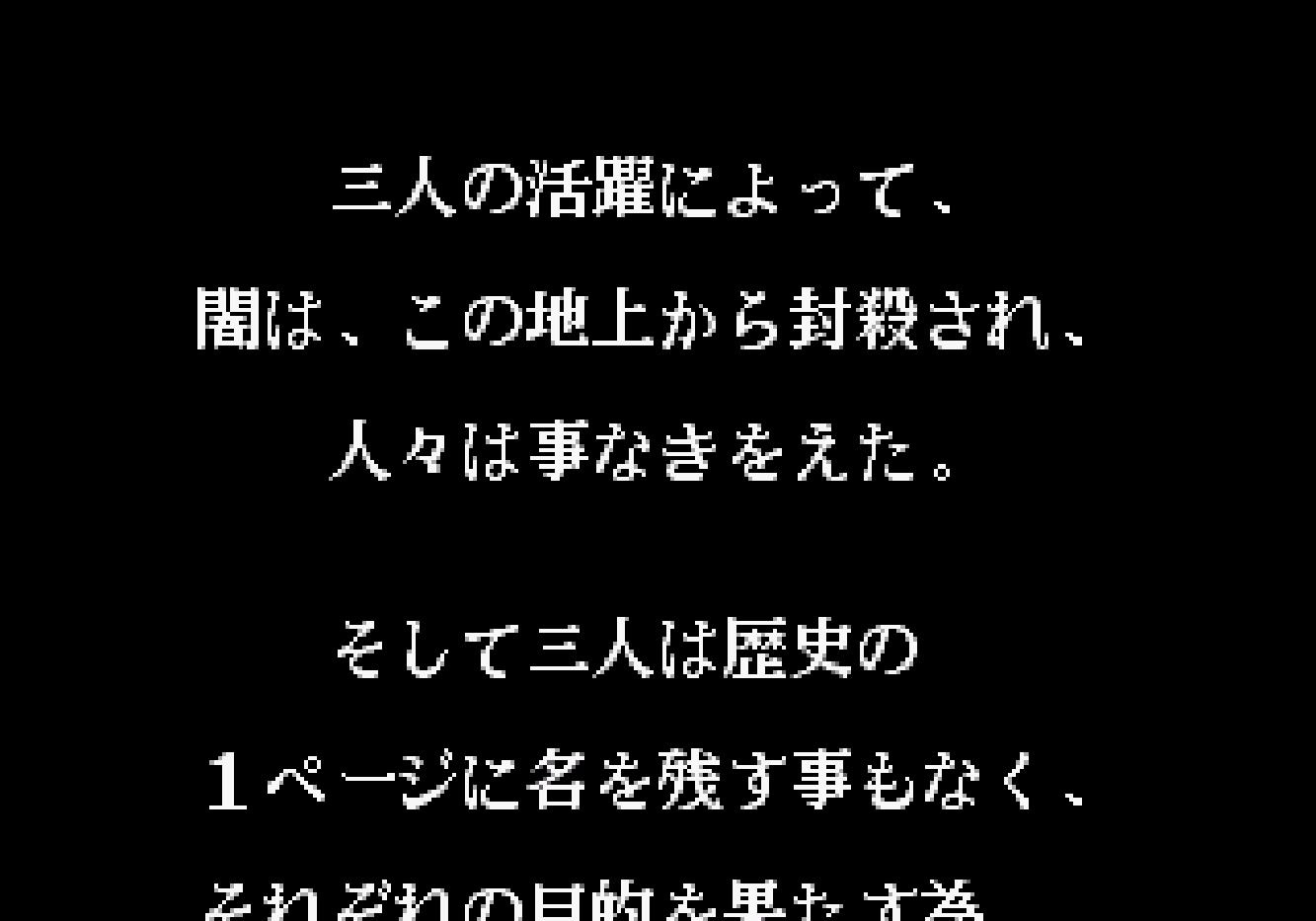Difference between revisions of "The King of Fighters '96"
From Sega Retro
| Line 48: | Line 48: | ||
Characters can become dizzy from being attacked repeatedly; they are uncontrollable and vulnerable in this state but can recover more quickly by rapidly pressing back and forth on the D-Pad along with the attack buttons. When stunned or grabbed, characters can call an undefeated team member in for a special assist attack with {{X}}+{{Y}}+{{A}}+{{B}} if they are visible in frame in that moment. Most team members have a 50% chance of helping, but some always help or never help, depending on the relationships between the characters. For example, Ryo always helps his sister Yuri, but Kyo never helps his rival Iori. | Characters can become dizzy from being attacked repeatedly; they are uncontrollable and vulnerable in this state but can recover more quickly by rapidly pressing back and forth on the D-Pad along with the attack buttons. When stunned or grabbed, characters can call an undefeated team member in for a special assist attack with {{X}}+{{Y}}+{{A}}+{{B}} if they are visible in frame in that moment. Most team members have a 50% chance of helping, but some always help or never help, depending on the relationships between the characters. For example, Ryo always helps his sister Yuri, but Kyo never helps his rival Iori. | ||
| − | Blocking can be done by holding the D-Pad in the opposite direction of the opponent. Low attacks must be blocked crouching, while high attacks (including most jumping attacks) must be blocked standing. Special moves still do partial damage when blocked. Characters can also block special moves and aerial attacks (but not grounded normal moves or Desperation moves) in midair from a neutral or backwards jump (but not a forwards jump). Throws can be performed by holding {{left}} or {{right}} and pressing a strong punch or kick button when next to the opponent. Different characters have different throws available to them. Throws cannot be blocked, but they can be escaped by pressing {{X}}+{{Y}} at the start of the grab. Characters can also recover from a knockdown | + | Blocking can be done by holding the D-Pad in the opposite direction of the opponent. Low attacks must be blocked crouching, while high attacks (including most jumping attacks) must be blocked standing. Special moves still do partial damage when blocked. Characters can also block special moves and aerial attacks (but not grounded normal moves or Desperation moves) in midair from a neutral or backwards jump (but not a forwards jump). Throws can be performed by holding {{left}} or {{right}} and pressing a strong punch or kick button when next to the opponent. Different characters have different throws available to them. Throws cannot be blocked, but they can be escaped by pressing {{X}}+{{Y}} at the start of the grab. Characters can also recover from a knockdown and roll away quickly by pressing {{X}}+{{Y}} upon landing. |
Each player has a power gauge at the bottom of the screen which charges when the character is blocking or taking attacks. It can also be filled manually, although it leaves the character vulnerable to an attack, by holding {{X}}+{{Y}}+{{A}}, which can only be done while standing. Once the power gauge is filled, the character enters "MAX mode," and basic attacks become stronger for a short period as the gauge drains. When characters are in this state, players can perform a Desperation move that immediately consumes the entire power gauge. Characters can perform Desperation moves indefinitely when the health gauge is nearly empty and flashing red. If both requirements are fulfilled (the character's health gauge is flashing red and the character's power gauge is full), the character performs a Super Desperation move instead. Super Desperation moves are typically variations of the Desperation move that hit more times or do more damage, but they sometimes have more significant differences. Characters in "MAX mode" can also cancel into a roll while blocking, but this costs the contents of the power gauge. | Each player has a power gauge at the bottom of the screen which charges when the character is blocking or taking attacks. It can also be filled manually, although it leaves the character vulnerable to an attack, by holding {{X}}+{{Y}}+{{A}}, which can only be done while standing. Once the power gauge is filled, the character enters "MAX mode," and basic attacks become stronger for a short period as the gauge drains. When characters are in this state, players can perform a Desperation move that immediately consumes the entire power gauge. Characters can perform Desperation moves indefinitely when the health gauge is nearly empty and flashing red. If both requirements are fulfilled (the character's health gauge is flashing red and the character's power gauge is full), the character performs a Super Desperation move instead. Super Desperation moves are typically variations of the Desperation move that hit more times or do more damage, but they sometimes have more significant differences. Characters in "MAX mode" can also cancel into a roll while blocking, but this costs the contents of the power gauge. | ||
| Line 81: | Line 81: | ||
| desc=The protagonist of the Orochi Saga. A Japanese high school student and heir of the Kusanagi clan, one of three clans that sealed away the legendary being known as Orochi. His clan possesses the Kusanagi Sword (草薙の剣), and his family crest is the sun, stylized as a halo of fire, which he wears on the back of his jacket. He has a nightmare in which he sees Goenitz, a member of the Hakkesshu, trying to revive Orochi, and he reassembles the team to defeat him. | | desc=The protagonist of the Orochi Saga. A Japanese high school student and heir of the Kusanagi clan, one of three clans that sealed away the legendary being known as Orochi. His clan possesses the Kusanagi Sword (草薙の剣), and his family crest is the sun, stylized as a halo of fire, which he wears on the back of his jacket. He has a nightmare in which he sees Goenitz, a member of the Hakkesshu, trying to revive Orochi, and he reassembles the team to defeat him. | ||
{{MoveListTable | desc=Special moves | | {{MoveListTable | desc=Special moves | | ||
| − | {{MoveListRow | 114 Shiki: Aragami | {{QCF}} {{LP}} | Kyo lunges forward with an explosive hook punch using his following arm. While the move is being performed, it can be followed up by a fiery uppercut (128 Shiki: Kono Kizu) with {{QCF}} {{punch}} or an elbow smash (127 Shiki: Yano Sabi) with {{HCB}} {{punch}}. The follow-up move can be followed up with a downward punch (Ge Shiki: Migiri Ugachi) with {{punch}} or a side kick (125 Shiki: Nanase) with {{kick}}.}} | + | {{MoveListRow | 114 Shiki: Aragami | {{QCF}} {{LP}} | Kyo lunges forward with an explosive hook punch using his following arm. This move can negate projectiles. While the move is being performed, it can be followed up by a fiery uppercut (128 Shiki: Kono Kizu) with {{QCF}} {{punch}} or an elbow smash (127 Shiki: Yano Sabi) with {{HCB}} {{punch}}. The follow-up move can be followed up with a downward punch (Ge Shiki: Migiri Ugachi) with {{punch}} or a side kick (125 Shiki: Nanase) with {{kick}}.}} |
| − | {{MoveListRow | 115 Shiki: Dokugami | {{QCF}} {{HP}} | Kyo steps forward with an explosive hook punch using his leading arm. While the move is being performed, it can be followed up by a backhand (401 Shiki: Tsumi Yomi) with {{HCB}} {{punch}} or a jumping attack (402 Shiki: Batsu Yomi) with {{right}}+{{punch}}.}} | + | {{MoveListRow | 115 Shiki: Dokugami | {{QCF}} {{HP}} | Kyo steps forward with an explosive hook punch using his leading arm. This move can negate projectiles. While the move is being performed, it can be followed up by a backhand (401 Shiki: Tsumi Yomi) with {{HCB}} {{punch}} or a jumping attack (402 Shiki: Batsu Yomi) with {{right}}+{{punch}}.}} |
{{MoveListRow | 100 Shiki: Oni Yaki<br>(Special {{Z}}) | {{DPF}} {{punch}} | Kyo twirls into the air while surrounded in a streak of red fire, which knocks down his opponent on impact. He ascends higher when the move is performed with {{HP}}.}} | {{MoveListRow | 100 Shiki: Oni Yaki<br>(Special {{Z}}) | {{DPF}} {{punch}} | Kyo twirls into the air while surrounded in a streak of red fire, which knocks down his opponent on impact. He ascends higher when the move is performed with {{HP}}.}} | ||
| − | {{MoveListRow | 910 Shiki: Nue | + | {{MoveListRow | 910 Shiki: Nue Tsumi | {{QCB}} {{punch}} | Kyo launches his opponent into the air with an uppercut. If he is attacked before the uppercut, he counters with an elbow drop (Ge Shiki: Ryuu Iri) against a high or mid attack or a downward flaming punch (Ge Shiki: Tora Fuse) against a low attack.}} |
{{MoveListRow | 75 Shiki: Kai<br>(Special {{C}}) | {{QCF}} {{kick}} | Kyo hops forward with a front kick that knocks his opponent over. He slides before hopping when the move is performed with {{HK}}. It can be followed up with another kick by pressing {{kick}} again.}} | {{MoveListRow | 75 Shiki: Kai<br>(Special {{C}}) | {{QCF}} {{kick}} | Kyo hops forward with a front kick that knocks his opponent over. He slides before hopping when the move is performed with {{HK}}. It can be followed up with another kick by pressing {{kick}} again.}} | ||
{{MoveListRow | 202 Shiki: Koto Tsuki You<br>(Special {{L}}) | {{HCB}} {{kick}} | Kyo runs into his opponent with an elbow strike, then lifts the opponent into the air with his hand and causes an explosion of red fire. He runs further when the move is performed with {{HK}}.}} | {{MoveListRow | 202 Shiki: Koto Tsuki You<br>(Special {{L}}) | {{HCB}} {{kick}} | Kyo runs into his opponent with an elbow strike, then lifts the opponent into the air with his hand and causes an explosion of red fire. He runs further when the move is performed with {{HK}}.}} | ||
| Line 467: | Line 467: | ||
{{MoveListTable | desc=Special moves | | {{MoveListTable | desc=Special moves | | ||
{{MoveListRow | Ka Chou Sen<br>(Special {{R}}) | {{QCF}} {{punch}} | Mai throws her folding fan at her opponent. The projectile moves faster when the move is performed with {{HP}}.}} | {{MoveListRow | Ka Chou Sen<br>(Special {{R}}) | {{QCF}} {{punch}} | Mai throws her folding fan at her opponent. The projectile moves faster when the move is performed with {{HP}}.}} | ||
| − | {{MoveListRow | Ryuu En Bu<br>(Special {{Z}}) | {{QCB}} {{punch}} | Mai twirls around, whipping her opponent with the sash around her waist, which is set alight and knocks her opponent over on impact. She steps forward slightly and the move can hit two times when it is performed with {{HP}}.}} | + | {{MoveListRow | Ryuu En Bu<br>(Special {{Z}}) | {{QCB}} {{punch}} | Mai twirls around, whipping her opponent with the sash around her waist, which is set alight and knocks her opponent over on impact. This move can negate projectiles. She steps forward slightly and the move can hit two times when it is performed with {{HP}}.}} |
{{MoveListRow | Hishou Ryuu'en Jin<br>(Special {{C}}) | {{DPF}} {{kick}} | Mai does a backflip while tailed by the sash around her waist, which is set alight and knocks her opponent over on impact. She flips higher when the move is performed with {{HK}}.}} | {{MoveListRow | Hishou Ryuu'en Jin<br>(Special {{C}}) | {{DPF}} {{kick}} | Mai does a backflip while tailed by the sash around her waist, which is set alight and knocks her opponent over on impact. She flips higher when the move is performed with {{HK}}.}} | ||
{{MoveListRow | Hissatsu Shinobi Bachi<br>(Special {{L}}) | {{HCF}} {{kick}} | Mai performs a cartwheel, then drops to the ground with an elbow strike that knocks her opponent over. The move travels more distance when it is performed with {{HK}}.}} | {{MoveListRow | Hissatsu Shinobi Bachi<br>(Special {{L}}) | {{HCF}} {{kick}} | Mai performs a cartwheel, then drops to the ground with an elbow strike that knocks her opponent over. The move travels more distance when it is performed with {{HK}}.}} | ||
Revision as of 01:42, 20 June 2024
| The King of Fighters '96 | |||||||||||||||
|---|---|---|---|---|---|---|---|---|---|---|---|---|---|---|---|
| System(s): Sega Saturn | |||||||||||||||
| Publisher: SNK | |||||||||||||||
| Developer: TUG[1], Yumekobo[2] | |||||||||||||||
| Original system(s): Neo Geo | |||||||||||||||
| Sound driver: SCSP/CD-DA (32 tracks) | |||||||||||||||
| Peripherals supported: Extended RAM Cartridge (1MB only) | |||||||||||||||
| Genre: Fighting Action/Kakutou Action (格闘アクション)[3], Action[4] | |||||||||||||||
| Number of players: 1-2 | |||||||||||||||
| Official in-game languages: | |||||||||||||||
| |||||||||||||||
|
The King of Fighters '96 (ザ・キング・オブ・ファイターズ’96) is an entry in SNK's The King of Fighters series. It is the third in the series, and the sequel to The King of Fighters '95. It was brought to the Sega Saturn in 1996.
The Saturn version was released late on the 31st of December, almost missing 1996 altogether. Though this version was released exclusively in Japan, it supports all the languages of the Neo Geo versions (Japanese, English, Spanish and Portuguese).
The King of Fighters '96 requires a 1MB Extended RAM Cartridge in order to function correctly. The later 4MB cartridge is incompatible; while the game will boot, graphics will be corrupted.
Contents
Story
A new King of Fighters tournament is announced. Since the previous year, the tournament's fame has grown immensely, turning it into a major international event. Huge corporations transform the King of Fighters tournament into a widely televised, commercialized, and celebrated event, drawing crowds from around the world. The tournament is now held by Chizuru Kagura, a descendant of the ancient Yata clan responsible for sealing the snake demon Orochi, along with the Kusanagi and Yasanaki clans. Each clan possesses one of the Three Sacred Treasures, ancient relics (based on the Imperial Regalia of Japan) that were used to seal Orochi. Chizuru uses the tournament in hopes of finding and recruiting Kyo and Iori in order to stop the upcoming Orochi threat.
Gameplay
The game is a team fighting game featuring characters from multiple SNK franchises. This entry adds increased maneuverability techniques, replacing the forward hop with the ability to run, replacing the dodge mechanic of the previous games with a new roll, and adding short hops. Command normals have been removed, most projectile attacks have been weakened, the inputs for many special moves have been simplified, throw escapes have been added, and "Super Desperation" moves have been introduced. Most of the sprites for returning characters have been redrawn or revised, some of the teams were rearranged, and several new characters were added (and some characters were removed).
As before, the playable characters are divided into multiple teams of three. The player can freely mix and match characters from different teams to form a custom team, but choosing characters from one of the canonical teams gives special endings in the arcade modes. Before each match, players arrange the team members in any order. For the first round of the match, the first member of each team fights. When a character is defeated, the following member of the team takes his or her place in the next round, while the character on the opposing team continues to fight and has a small portion of health restored (more health is restored if the round is completed faster). The other members of the team stand in the background of the stage during the fight. The match ends when all three members of either team are defeated.
Characters move with ![]() and
and ![]() and crouch with
and crouch with ![]() . They backstep or run with
. They backstep or run with ![]()
![]() or
or ![]()
![]() . They jump upward with
. They jump upward with ![]() and jump behind and ahead with
and jump behind and ahead with ![]() or
or ![]() . They can perform short hops by pressing
. They can perform short hops by pressing ![]() ,
, ![]() , or
, or ![]() , followed by
, followed by ![]() quickly. They can "super jump" (a faster and farther jump, trailed by afterimages) by pressing
quickly. They can "super jump" (a faster and farther jump, trailed by afterimages) by pressing ![]() , then
, then ![]() or
or ![]() quickly. Characters can perform a weak punch with
quickly. Characters can perform a weak punch with ![]() , a strong punch with
, a strong punch with ![]() , a weak kick with
, a weak kick with ![]() , or a strong kick with
, or a strong kick with ![]() . Each character has a set of basic, unique, and special moves that can be performed by the player with a specific series of button inputs.
. Each character has a set of basic, unique, and special moves that can be performed by the player with a specific series of button inputs.
Characters have knockdown attacks, which knock the opponent over, that are performed with ![]() +
+![]() . This can be done while standing or jumping. Characters can perform evasive rolls with
. This can be done while standing or jumping. Characters can perform evasive rolls with ![]() +
+![]() to roll backward or
to roll backward or ![]() +
+![]() +
+![]() to roll forward (or
to roll forward (or ![]() +
+![]() +
+![]() when facing left). Characters are invulnerable during most of the roll, though they can still be grabbed and thrown. They can roll through opponents when they are close.
when facing left). Characters are invulnerable during most of the roll, though they can still be grabbed and thrown. They can roll through opponents when they are close.
Characters can become dizzy from being attacked repeatedly; they are uncontrollable and vulnerable in this state but can recover more quickly by rapidly pressing back and forth on the D-Pad along with the attack buttons. When stunned or grabbed, characters can call an undefeated team member in for a special assist attack with ![]() +
+![]() +
+![]() +
+![]() if they are visible in frame in that moment. Most team members have a 50% chance of helping, but some always help or never help, depending on the relationships between the characters. For example, Ryo always helps his sister Yuri, but Kyo never helps his rival Iori.
if they are visible in frame in that moment. Most team members have a 50% chance of helping, but some always help or never help, depending on the relationships between the characters. For example, Ryo always helps his sister Yuri, but Kyo never helps his rival Iori.
Blocking can be done by holding the D-Pad in the opposite direction of the opponent. Low attacks must be blocked crouching, while high attacks (including most jumping attacks) must be blocked standing. Special moves still do partial damage when blocked. Characters can also block special moves and aerial attacks (but not grounded normal moves or Desperation moves) in midair from a neutral or backwards jump (but not a forwards jump). Throws can be performed by holding ![]() or
or ![]() and pressing a strong punch or kick button when next to the opponent. Different characters have different throws available to them. Throws cannot be blocked, but they can be escaped by pressing
and pressing a strong punch or kick button when next to the opponent. Different characters have different throws available to them. Throws cannot be blocked, but they can be escaped by pressing ![]() +
+![]() at the start of the grab. Characters can also recover from a knockdown and roll away quickly by pressing
at the start of the grab. Characters can also recover from a knockdown and roll away quickly by pressing ![]() +
+![]() upon landing.
upon landing.
Each player has a power gauge at the bottom of the screen which charges when the character is blocking or taking attacks. It can also be filled manually, although it leaves the character vulnerable to an attack, by holding ![]() +
+![]() +
+![]() , which can only be done while standing. Once the power gauge is filled, the character enters "MAX mode," and basic attacks become stronger for a short period as the gauge drains. When characters are in this state, players can perform a Desperation move that immediately consumes the entire power gauge. Characters can perform Desperation moves indefinitely when the health gauge is nearly empty and flashing red. If both requirements are fulfilled (the character's health gauge is flashing red and the character's power gauge is full), the character performs a Super Desperation move instead. Super Desperation moves are typically variations of the Desperation move that hit more times or do more damage, but they sometimes have more significant differences. Characters in "MAX mode" can also cancel into a roll while blocking, but this costs the contents of the power gauge.
, which can only be done while standing. Once the power gauge is filled, the character enters "MAX mode," and basic attacks become stronger for a short period as the gauge drains. When characters are in this state, players can perform a Desperation move that immediately consumes the entire power gauge. Characters can perform Desperation moves indefinitely when the health gauge is nearly empty and flashing red. If both requirements are fulfilled (the character's health gauge is flashing red and the character's power gauge is full), the character performs a Super Desperation move instead. Super Desperation moves are typically variations of the Desperation move that hit more times or do more damage, but they sometimes have more significant differences. Characters in "MAX mode" can also cancel into a roll while blocking, but this costs the contents of the power gauge.
Characters can taunt with ![]() +
+![]() , which is a short animation during which the character is vulnerable to attack. Taunting an opponent can reduce their power gauge, slow down their manual charging, and stop them from reaching the maximum level.
, which is a short animation during which the character is vulnerable to attack. Taunting an opponent can reduce their power gauge, slow down their manual charging, and stop them from reaching the maximum level.
Modes
The game has the following modes:
- Team Play: A single-player mode where the player forms a team of any three characters and fights three-on-three elimination matches against all of the teams in the game (ending with the bosses Chizuru Kagura and Goenitz), for a total of 11 matches. There are storyline intermissions throughout the game. This is the main mode.
- Team Vs: A two-player mode where each player forms a team of any three characters and fights a three-on-three elimination match. Players can choose a different team after each match.
- Single Play: A single-player mode where the player chooses a character and fights one-on-one matches against one character from every team (ending with the bosses Chizuru Kagura and Goenitz), for a total of 11 matches. Matches are fought to the best of three rounds. There are storyline intermissions throughout the game.
- Single Vs: A two-player mode where each player chooses a single character and fights a one-on-one match to the best of three rounds. Players can choose a different character after each match.
- Survivor: A single-player mode where the player chooses a character and fights one-on-three matches against all of the teams in the game (ending with the bosses Chizuru Kagura and Goenitz), for a total of 11 matches. The character does not have any health restored between matches aside from the amount partially restored after each round (depending on the player's performance).
In any of the single-player modes, a second player can enter the game for a challenge match by pressing START on a second control pad. There are eight difficulty levels (Beginner, Easy, Normal, MVS, Hard, Very Hard, Hardest, Expert). The game ends if the player loses a match but can be continued an unlimited number of times. This is the last King of Fighters game where the player fights every team in the single-player mode.
Characters
Note: Move lists assume that the character is facing right. When facing left, ![]() and
and ![]() should be reversed.
should be reversed.
| P | Any punch button |
| LP | Light punch |
| HP | Hard punch |
| K | Any kick button |
| LK | Light kick |
| HK | Hard kick |
Most of the characters from the previous game return, but the Rivals Team was disbanded, with only Iori Yagami returning, and Heidern and Takuma Sakazaki retired from the tournament.
The new characters from other SNK games are Kasumi Todoh from Art of Fighting 3 and a new Boss Team consisting of Geese Howard from Fatal Fury, Wolfgang Krauser from Fatal Fury 2, and Mr. Big from Art of Fighting. The new original characters are Leona, an amnesiac raised by Heidern who is linked to the Orochi plotline; Mature and Vice, Rugal's secretaries who are now playable; and Chizuru Kagura and Goenitz, the two bosses.
In the options, players can set the function of the extra buttons on the Saturn control pad under the "Play Style" setting. Normal leaves them unassigned (which is the default setting), Simple assigns special mechanics to them that usually take multiple button presses (similar to the default assignments in King of Fighters '95), and Special assigns special moves to them (which vary by character). The assignments for the Simple control scheme are ![]() for evasive rolls,
for evasive rolls, ![]() for knockdown attacks,
for knockdown attacks, ![]() for taunting, and
for taunting, and ![]() to power up or for a support attack.
to power up or for a support attack.
Shujinkou Team
A Japanese team consisting of Kyo Kusanagi, the main character of the Orochi Saga, and his allies, who have banded together again to fight Goenitz.
Garou Densetsu Team
A team representing characters from the Fatal Fury series of fighting games. They join the tournament after learning that Geese Howard is an invited guest.
|
Terry Bogard | ||||||||||||||||||||||||||
The protagonist of the Fatal Fury series. He enters the tournament to once again face his nemesis Geese Howard.
| |||||||||||||||||||||||||||
|
Andy Bogard | ||||||||||||||||||||||||||
Terry's brother and a ninja of the Shiranui-ryuu style.
| |||||||||||||||||||||||||||
|
Joe Higashi | ||||||||||||||||||||||||||
A Muay Thai kickboxing champion and a good friend of the Bogard brothers.
|
Ryuuko no Ken Team
A team representing characters from the Art of Fighting series of fighting games. Yuri Sakazaki takes the place of her father, Takuma, after his retirement.
|
Ryo Sakazaki | |||||||||||||||||||||||||||||||||||
The protagonist of the Art of Fighting series. He is a practitioner of Kyokugen-ryuu, a style of karate created by his father.
| ||||||||||||||||||||||||||||||||||||
|
Robert Garcia | |||||||||||||||||||||||||||||||||||
Ryo's best friend and friendly rival who fights using a kick-heavy version of Kyokugen-ryuu. He comes from a wealthy family.
| ||||||||||||||||||||||||||||||||||||
|
Yuri Sakazaki | |||||||||||||||||||||||||||||||||||
The younger sister of Ryo, who fights with an unorthodox take on Kyokugen-ryuu.
|
Shin Ikari Team
A new team representing characters from the Ikari Warriors series of run-and-gun games. Heidern has decided not to participate this year, having fulfilled his goal of killing Rugal, so his adopted daughter Leona takes his place.
|
Leona | ||||||||||||||||||||||||||||||||
A new recruit to the squad. She was found and adopted by Heidern, who found her after her village was destroyed and her family was murdered by the Hakkesshu. She has lost her memory but resolves to take revenge upon Goenitz.
| |||||||||||||||||||||||||||||||||
|
Ralf Jones | ||||||||||||||||||||||||||||||||
The protagonist of the Ikari Warriors series. He is a mercenary whose fighting style is based on hard punches.
| |||||||||||||||||||||||||||||||||
|
Clark Still | ||||||||||||||||||||||||||||||||
Ralf's best friend and a former spy before joining the Ikari Warriors. He fights with a wrestling-based fighting style.
|
Psycho Soldier Team
A team representing characters from the Psycho Soldier series of platforming games. They join the tournament to put their powers and training to the test.
|
Athena Asamiya | ||||||||||||||||||||||||||||||||
The protagonist of Psycho Soldier. She is a pop idol with powerful psychic abilities and kung fu training (with a greater emphasis on the former).
| |||||||||||||||||||||||||||||||||
|
Sie Kensou | ||||||||||||||||||||||||||||||||
The self-proclaimed love interest of Athena, who has the same psychic abilities and kung fu training as Athena (though his fighting style emphasizes the latter).
| |||||||||||||||||||||||||||||||||
|
Chin Gentsai | ||||||||||||||||||||||||||||||||
The master of Athena and Kensou and a master of various styles of kung fu, though he fights primarily with drunken boxing.
|
Kim Team
A Korean team consisting of Kim Kaphwan (from Fatal Fury) and two original characters. They join the tournament so Kim can prove the effectiveness of his criminal rehabilitation program.
|
Kim Kaphwan | |||||||||||||||||||||||||||||
A taekwondo master with a strong sense of justice who formed the Korea Justice Team in order to rehabilitate the two criminals on his team.
| ||||||||||||||||||||||||||||||
|
Chang Koehan | |||||||||||||||||||||||||||||
A very large criminal who fights with a big metal ball attached to a chain.
| ||||||||||||||||||||||||||||||
|
Choi Bounge | |||||||||||||||||||||||||||||
A very small criminal who fights with two clawed hands (resembling the horror movie villain Freddy Krueger).
|
Shin Josei Kakutouka Team
A new Women Fighters Team, with Kasumi Todoh (from Art of Fighting 3) taking the place of Yuri Sakazaki, who joined her brother's team.
|
Kasumi Todoh | |||||||||||||||||||||||||||||||||||
An Aikido student who is searching for her father, Ryuhaku Todoh (from the first Art of Fighting game).
| ||||||||||||||||||||||||||||||||||||
|
Mai Shiranui | |||||||||||||||||||||||||||||||||||
A kunoichi who practices her family's own martial art, Shiranui-ryuu Ninjutsu.
| ||||||||||||||||||||||||||||||||||||
|
King | |||||||||||||||||||||||||||||||||||
A bar owner who fights with her own kick-heavy take on Muay Thai.
|
Yagami Team
A new team consisting of Iori Yagami, rival to protagonist Kyo Kusanagi, and Rugal's former secretaries Mature and Vice. They enter the tournament with the goal of killing Kyo. It is always the second-to-last team fought before facing the bosses in the arcade modes.
|
Iori Yagami | |||||||||||||||||||||||
The last heir to the Yagami clan (formerly known as the Yasakani Clan), one of the three clans that sealed away Orochi. His clan possesses the Yasakani Jewel (八尺瓊曲玉), and his family crest is the crescent moon, which he wears on the back of his jacket. Iori forms a team with Mature and Vice in the hopes of finally killing his hated rival Kyo.
| ||||||||||||||||||||||||
|
Mature | |||||||||||||||||||||||
A member of the Hakkesshu brotherhood who was assigned to watch over Rugal, taking the role of one of his assistants. She has now been ordered by Goenitz to assist Iori to ensure that he progresses to the championship finals. She fights with her sharp nails.
| ||||||||||||||||||||||||
|
Vice | |||||||||||||||||||||||
A member of the Hakkesshu brotherhood who was assigned to watch over Rugal, taking the role of one of his assistants. She has now been ordered by Goenitz to assist Iori to ensure that he progresses to the championship finals. She fights with her monstrous strength.
|
Boss Team
A new team consisting of the bosses of three games: Geese Howard (Fatal Fury), Wolfgang Krauser (Fatal Fury 2), and Mr. Big (Art of Fighting). It is always the last team fought before facing the bosses in the arcade modes.
|
Geese Howard | |||||||||||||||||||||||||||||
The nemesis of the Bogard brothers. He enters the tournament under the guise of seeking revenge against Terry Bogard, but he really wants to learn more about Orochi's power.
| ||||||||||||||||||||||||||||||
|
Wolfgang Krauser | |||||||||||||||||||||||||||||
Geese's half-brother, who enters the tournament to test his strength.
| ||||||||||||||||||||||||||||||
|
Mr. Big | |||||||||||||||||||||||||||||
A crime boss who enters the tournament to try to expand the influence of his criminal organization.
|
Bosses
Both bosses are new characters and can be played using a cheat code.
|
Chizuru Kagura | |||||||||||||||||||||||
The heiress of the Yata clan, one of the three clans to seal away Orochi. She hosts the tournament in order to bring the descendants of the three clans together to prevent Orochi from being revived by the Hakkesshu. Her clan possesses the Yata Mirror (八汰鏡). She fights with dance-like motions and open-handed strikes and can create mirror images of herself. She is harmed if one of her mirror images is attacked. She is the sub-boss of the game.
| ||||||||||||||||||||||||
|
Goenitz | |||||||||||||||||||||||
A priest of the Hakkesshu, a cult of Orochi's devoted followers. He the strongest of the Four Heavenly Kings of Orochi and can control wind. He seeks to revive his master. It is revealed that he is the one who gave Rugal a small portion of Orochi's blood in The King of Fighters '95. He is the final boss of the game.
|
Special Edit Teams
The game is the first in the series to introduce the concept of Special Edit Teams, which are custom teams that the player can form that have their own endings. There are only two Special Edit Teams in this game.
The first is the Three Sacred Treasures Team, formed by choosing Kyo Kusanagi, Iori Yagami, and (with a cheat code) Chizuru Kagura. These are the descendants of the three clans that sealed away Orochi in the past. The canonical ending to the game is only seen when the game is completed with this team. Chizuru asks Kyo and Iori to work together in order to prevent Orochi from being resurrected, but because of the longstanding feud between their clans, they refuse.
The second is the Goenitz Team, formed by putting Goenitz (using a cheat code) on a team with any other characters. In the ending, Chizuru appears and explains that the Goenitz on the player's team was an illusion.
Stages
Every team has their own stage where they are faced. The stage is chosen based on the first member of the opposing team when facing a mixed team.
Versions
The Saturn version of The King of Fighters '96 stems from the Neo Geo CD and shares its arranged CD audio soundtrack. Loading times are faster on the Saturn than on the Neo Geo CD, though sound effects have been lowered in quality and some stage introduction special effects are missing. Animations on the character selection screen are missing in all CD versions of the game, as are team reactions when the player is slammed into the ground during a fight.
The Saturn compares favourably to its PlayStation counterpart, which in addition to the aforementioned cuts, lacks many character and background animations. The PlayStation port also manages to load slower than the Neo Geo CD at times, despite its disc drive being twice as fast.
Production credits
- Producer: T・Nishiyama
- Chief Director: Kuwayan
- System Director: Toyochan
- Sub Director: Toyochan, Haruo Tomita, Namaan-Hiroto, T.Hosokawa
- System Editor: K・Mac・Nagashima
- Front Designer: Tatsuru-Man, C・Yamasaki, Goro Hamada, Akihiko Nasu, Kyow!Iori?Hiraki, Shagiko Hagihara, Naisyo・・・・, M・Asakura, Joe・Terry Sato, Toba, ・・・・・, Miho Uematsu, Akiko Yukawa, S.Yamamoto, Kal-Mizuno, Mitsuru Kawasaki, Kohrin, (Mika) Nisida, I-no-u-e, 44Oka, Aska Tahara
- Back Designer: Etosan, Manoru, Bibidebabidebu, Tsugumi.A, Eri Koujitani, [214 Kusu], Souji Takamori, M.Yokoyama, Raishi
- Program: Shinchan-R32, S・Fujinuki, Cyber・Kondo
- Sound: Sha-V, Konny, Papaya, Shimizm, Yamapy-1, Tate-Norio, Brother-Hige, Ackey, Miwa
- Voice: Masahiro Nonaka, Monster Maetsuka, Masaki Usui, S・Hashimoto, Keiichi Nanba, Nobuyuki Hiyama, Koichi Mantaro, Kaori Horie, Masae Yumi, Yoshinori Shima, Tamao Sato, Eiji Yano, T・Nishimura, Hiroyuki Arita, Harumi Ikoma, Akoya Sogi, Kunihiko Yasui, Yuko Tuji, Kong Kuwata, BJ Love, Masaru Naka, Akiko Saito
- Special Thanks to: Y・Inui, Team Pow, Team Syunsuke 96, M.Yasuda, Kazu,Takinaka, and All SNK Staff
- Produced by: SNK
- (有)TUG
- プログラマー: 林 高志, 小島 卓也, 村岡 敬, 黒川 昌昭
- (株)夢工房
- 赤池 光雄, 井上 和俊, 近藤 和夫, 渋谷 麻紀夫
- ミュージックスタジオ: ファースト・サークル
- サウンド: 藤田 靖明
Magazine articles
- Main article: The King of Fighters '96/Magazine articles.
Promotional material
Physical scans
| Sega Retro Average | |||||||||||||||||||||||||||||||||||||||||||||||||
|---|---|---|---|---|---|---|---|---|---|---|---|---|---|---|---|---|---|---|---|---|---|---|---|---|---|---|---|---|---|---|---|---|---|---|---|---|---|---|---|---|---|---|---|---|---|---|---|---|---|
|
| 86 | |
|---|---|
| Based on 9 reviews | |
Technical information
- Main article: The King of Fighters '96/Technical information.
References
- ↑ http://gdri.smspower.org/wiki/index.php/TUG
- ↑ http://gdri.smspower.org/wiki/index.php/Yumekobo
- ↑ File:KoF96 Saturn JP Box Back.jpg
- ↑ 4.0 4.1 https://sega.jp/fb/segahard/ss/soft_licensee2.html (Wayback Machine: 2020-03-20 23:05)
- ↑ 5.0 5.1 Sega Saturn Magazine, "1996-21 (1996-12-13)" (JP; 1996-11-22), page 11
- ↑ File:KOF96 Saturn JP SSEnding.pdf
- ↑ Computer & Video Games, "May 1997" (UK; 1997-04-11), page 12
- ↑ Famitsu, "1997-01-10,17" (JP; 1996-12-27), page 1
- ↑ GameFan, "Volume 5, Issue 4: April 1997" (US; 1997-xx-xx), page 26
- ↑ MAN!AC, "03/97" (DE; 1997-02-12), page 42
- ↑ Saturn Fan, "1997 No. 1" (JP; 1996-12-27), page 199
- ↑ Saturn Fan, "1997 No. 4" (JP; 1997-02-14), page 110
- ↑ Saturn Power, "August 1997" (UK; 1997-06-25), page 86
- ↑ Sega Saturn Magazine, "1997-01 (1997-01-17)" (JP; 1996-12-27), page 231
- ↑ Sega Saturn Magazine, "Readers rating final data" (JP; 2000-03), page 11
| The King of Fighters '96 | |
|---|---|
|
Main page | Comparisons | Hidden content | Magazine articles | Reception | Technical information | Bootlegs
| |
| The King of Fighters games for Sega systems or published by Sega | |
|---|---|
| The King of Fighters '95 (1996) | The King of Fighters '96 (1996) | The King of Fighters '96 + '95: Gentei KOF Double Pack (?) | The King of Fighters '97 (1998) | The King of Fighters Best Collection (1998) | |
| The King of Fighters: Dream Match 1999 (1999) | The King of Fighters: Evolution (2000) | The King of Fighters 2000 (2002) | The King of Fighters 2001 (2002) | The King of Fighters 2002 (2003) | |
| The King of Fighters Neowave (2004) | The King of Fighters XI (2005) | |
| The King of Fighters XIV (2016) | |
| Unlicensed The King of Fighters games for Sega systems | |
| King of Fighters 98' (1998) | The King of Fighters '99 (1999) | Jue Zhan Tian Huang (2000) | |
| Related games | |
| Capcom vs. SNK: Millennium Fight 2000 (2000) | Capcom vs. SNK Millennium Fight 2000 Pro (2000) | Capcom vs. SNK 2 Millionaire Fighting 2001 (2001) | NeoGeo Battle Coliseum (2005) | SNK Heroines: Tag Team Frenzy (2018) | |
